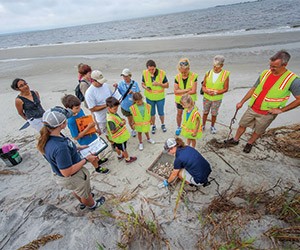In September 1863, Confederate and Union troops clashed at the bloody two-day Battle of Chickamauga in Georgia’s northwest corner, followed by the Chattanooga Campaign in adjacent Eastern Tennessee. The first fight was the Confederate Army’s last major victory of the Civil War.
Dedicated in 1895, Chickamauga and Chattanooga National Military Park was the first such site created by Congress to preserve battle sites of national importance. Comprising the 5,200-acre Chickamauga Battlefield in Fort Oglethorpe, Ga., and the 3,000-acre Lookout Mountain Battlefield in Lookout Mountain, Tenn., the monument-rich park defines a quintessential aspect of the Georgia experience: The past here remains vividly alive.
Each year, U.S. Army officers and their allies come to the park to study the battles fought here. Known as “Staff Rides,” these visits are symbolic of how groups can connect with experiences deep-rooted in Georgia’s ever-present history and heritage.
Atlanta History Center, Atlanta
Founded in 1926, this scenic 33-acre campus in Buckhead features six historic gardens and a collection of memorable event-capable venues, including the Atlanta History Museum and the Centennial Olympic Games Museum.
The center’s trio of landmark historic homes includes the popular Margaret Mitchell House. Set on two acres in midtown Atlanta, this is where Mitchell wrote Gone With the Wind. Back in Buckhead, the 1860s Tullie Smith Farm and stately 1929 Swan House are evocative backdrops for functions.
With a wall of 14-foot windows overlooking the Quarry Garden, the regal Grand Outlook is among Atlanta’s most desirable ballrooms, while McElreath Hall, containing the Members Room and Woodruff Auditorium, is an elegant choice for weddings, corporate events and board meetings. PageBreak
Southern Museum of Civil War & Locomotive History, Kennesaw
In April 1862, Union spies stole The General locomotive from a Confederate camp and charged toward Chattanooga, Tenn., destroying telegraph wires and rails with the Confederates in hot pursuit. Remembered as the “Great Locomotive Chase of 1862,” this action started in former Big Shanty, Ga., now Kennesaw, just north of Atlanta in Cobb County.
The General itself is the star attraction at this Smithsonian-affiliated museum, which features exhibits on Georgia’s rail heritage along with Civil War artifacts and relics.
Housed in a former cotton gin, the museum can flexibly accommodate gatherings of up to 500 guests, including outdoor events on the lawn panoramically overlooking Kennesaw and the historic railroad tracks.
Taylor-Grady House, Athens
Built in the 1840s by Gen. Robert Taylor as a family summer home, this gracious antebellum mansion then became the home of acclaimed Atlanta Constitution editor Henry Grady, a preeminent voice for the New South after the Civil War.
Designated a National Historic Landmark in 1976, the Greek Revival structure features original furnishings and is available for social and corporate functions. With rentals including exclusive use of the house and grounds, the facility can accommodate up to 550 guests for events, with indoor space for up to 210 guests and the back lawn or boxwood garden for outdoor gatherings.
Old Governor's Mansion, Milledgeville
Starting with Savannah in 1777, Georgia rotated capital cities 14 times before deciding on Atlanta in 1868. Serving the role from 1807 to 1867, Milledgeville, east of Macon, is home to this handsome antebellum treasure. Completed in 1839, the mansion briefly served as Gen. Sherman’s headquarters on his infamous March to the Sea.
Now a museum on the Georgia College & State University campus, the National Historic Landmark building welcomes tours and events.
“Groups have a unique opportunity to learn about significant history in the location where it took place,” says Matthew Davis, the museum’s curator.PageBreak
Augusta Museum of History, Augusta
Sent to live with his aunt in Augusta at age four, James Brown, the Godfather of Soul, is featured among the permanent exhibitions at this engaging museum in Augusta’s central business district. With other showcases such as Augusta’s rich golf heritage, the museum also offers versatile space for groups.
“Available day or evening to corporate and professional organizations as well as private individuals, the museum is a grand, elegant space for hosting special events,” says Nancy Glaser, the museum’s executive director.
With full buyouts including a private viewing of the galleries, rental spaces include the octagonal Rotunda, accommodating up to 400 guests for a standing reception.
National Civil War Naval Museum, Columbus
Established to preserve two Confederate warships recovered from the adjacent
Chattahoochee River, this interpretative facility is an enthralling choice for groups in historic Columbus. Signature exhibits include the CSS Jackson, one of the largest ironclads built by the Confederacy. Set ablaze by Union raiders in 1865, the ship sank some 30 miles south of Columbus before being raised in 1961.
Outside, exhibits include a full-scale replica of the USS Water Witch, a Union side-wheel steamship captured and destroyed near Savannah in 1864. Versatile spaces include the Main Gallery and Exhibit Overlook, accommodating 184 guests banquet-style and 84 theater-style, respectively.
Telfair Museums, Savannah
In charming Savannah, a distinctive gathering place for more than 300 years, Telfair Museums, the oldest public art museum in the Southeast, has been a local fixture since 1883.
Along with the contemporary Jepson Center, this celebrated institution consists of two National Historic Landmark buildings, both completed around 1820. At Telfair Academy, event spaces include the three-story Rotunda, accommodating up to 250 for a cocktail reception, and the Sculpture Gallery, hosting up to 150 guests. Among the finest examples of English Regency architecture in America, the Owens-Thomas House includes a romantic garden ideal for late afternoon and evening events.
Fort King George Historic Site, Darien
Revolutionary and Civil War forts dot Georgia’s southern coastline, along with historic lighthouses. From 1721 until 1736, Fort King George was the British Empire’s southernmost outpost in North America, making it the oldest English fort remaining on Georgia’s coast. Reconstructed for tours and events, this frontier fortification scenically overlooks a salt marsh and the Altamaha River.
“The historic site offers oyster roasts, colonial-themed dinners and cannon firings for private groups,” says Kim Hatcher, public affairs coordinator for Georgia State Parks & Historic Sites. “The staff is happy to work with planners to arrange personalized programs for all interests.”
Regular Meetings Focus contributor Jeff Heilman finds Georgia unimpeachably irresistible.







